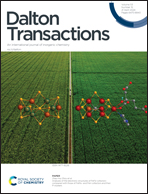Photochromism and single-component white light emission from a metalloviologen complex based on 1,5-naphthyridine†
Abstract
Metalloviologens, as emerging electron-transfer photochromic compounds, have shown intriguing properties such as radiochromism, photochromism and photoconductance. However, only a limited number of them have been reported so far. Exploration of new metalloviologens is strongly desired. Herein, we report a new solvothermally synthesized metalloviologen complex [CdCl2(ND)2]n (1, ND = 1,5-naphthalenes) that exhibits photochromic and intrinsic white light emission properties. Density functional theory calculation results reveal that the photochromism could be assigned to photoinduced electron transfer from chlorine atoms to ND molecules. The photoinduced charge-separated states are heat/air stable, attributed to the delocalization of ND and strong intermolecular π–π interactions. Besides, complex 1 consistently emits intrinsic white light when excited with 340–370 nm UV light, achieving high color rendering index (CRI) values (82.54–94.04). By adjusting the excitation wavelength, both “warm” and “cold” white light emission can be produced, making it suitable for the application of a white light emitting diode (WLED). Thus, this work demonstrates that the ND-based metalloviologen is not only helpful in producing photochromism, but also beneficial for creating white-light emission.



 Please wait while we load your content...
Please wait while we load your content...